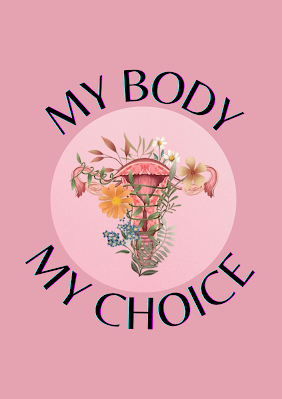
Journalism and political communication - Task 3
Section 1: Abortion Laws, Public Opinion, and Advocacy Across Europe
Europe has very different abortion regulations, ranging from progressive to quite restricted. Abortion is legal on request throughout the first trimester in the majority of nations, including France, Germany, and Sweden; however, certain countries enable longer access under certain conditions, such as foetal abnormalities or medical reasons (Centre for Reproductive Rights, 2022).
Abortion is legal in the Netherlands up to 22 weeks and in Sweden up to 18 weeks (Statista, 2020). Nonetheless, nations such as Poland enforce strict prohibitions, allowing abortion only in situations involving rape, incest, or when the mother's life is in danger (Reuters, 2024). The only EU nation that completely prohibits abortion is Malta, which permits it only in cases where the mother's life is in danger (Council of Europe, 2022).
Abortion prices in Europe vary greatly. While women in more restrictive countries frequently incur significant costs when travelling to countries where abortion is legal, like the UK or the Netherlands, countries like Sweden and the UK offer abortion services through public healthcare systems at no cost to the patient (Guttmacher Institute, 2022).
The general public's views on abortion also differ. According to the Pew Research Centre (2024), 95% of people in Sweden are in favour of legal abortion, whereas just 56% of people in Poland are in favour of it. While conservative religious organisations, such as the Catholic Church, have a major impact on policy in nations like Malta and Poland, advocacy activities are spearheaded by organisations like Amnesty International (Council of Europe, 2022). In the fight for reproductive rights, demonstrations like those in Italy in 2023 and Poland in 2021 have been crucial (Reuters, 2024; AP News, 2024).
The abortion debate in Europe has been influenced by a number of significant individuals. Abortion rights have been strongly defended by French President Emmanuel Macron, who has stated that "women's rights to their bodies must always be protected" (Reuters, 2022).
Mateusz Morawiecki, the prime minister of Poland, on the other hand, backed tight abortion regulations on the grounds that "life must be protected at all costs" (BBC, 2023). The head of the right-wing Brothers of Italy, Italian Prime Minister Giorgia Meloni, has stated that she is against increasing access to abortion and has called for a review of abortion regulations (AP News, 2024).
Reproductive rights activists, such as Nobel laureate Malala Yousafzai, emphasise that "every woman deserves the right to make decisions about her own body". Declaring that "abortion is a right, not a privilege," and endorsing Spain's progressive abortion laws, feminist activist Irene Montero has been a strong voice for reproductive justice in Spain.
Section 2: Poster Designs and Visual Representation
Poster 1's bold black writing and prominent red background create a dramatic contrast that exudes seriousness, passion, and urgency. The hand-drawn font style provides authenticity and a grassroots sense, while the robust, block-type font in capital lettering highlights strength and assertiveness. A body silhouette, representing bodily autonomy, serves as the design's focal point. The layout is consistently spaced and vertically orientated to guarantee clarity and highlight the content.
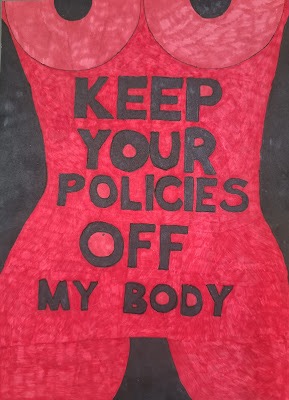
Poster 2's subdued pink and green colour scheme evokes balance, contemplation, and serenity. The soft pink middle area is delicately framed by a green border. A circular arrangement of serif fonts adds style, originality, and movement while representing flexibility and options. With butterflies signifying change and liberation, the minimalist line art of a woman with flowers for a head symbolises development and uniqueness. The organic and symmetrical design promotes harmony and inclusivity.
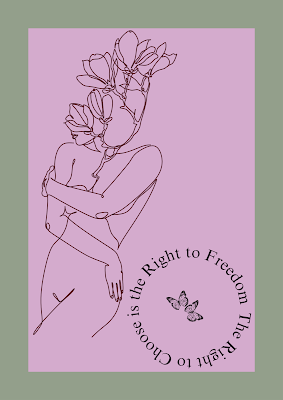
In order to encourage empathy, harmony, and development, Poster 3 uses a warm pink background with flower tones in green, yellow, and blue. Delivering an inspiring message like "My Body, My Choice" is made clear and approachable with big, capitalised letters in a modern sans-serif typeface. Encircled by floral patterns that convey life, health, and positivity, a central circular frame enclosing an illustration of a uterus signifies inclusivity and unity while reinforcing themes of reproduction, growth, and autonomy. A balanced and eye-catching layout is guaranteed by the arced text positioning.

Poster 4's purple background, which stands for strength, knowledge, and unity, is contrasted with warm yellow, orange, and pink text and flowers to inspire hope and optimism. "Abortion Rights Are Human Rights," the main statement, is kept front and centre thanks to the muted tones of the hands and uterus, which produce a balanced aesthetic. While the alignment and consistent text spacing improve readability and clarity, a serif font adds elegance and authority, highlighting the seriousness of the message. In addition to symmetrical hands extending towards a uterus to symbolise group care, support, and fight for reproductive rights, the design is framed with colourful flower components that symbolise life and natural harmony.
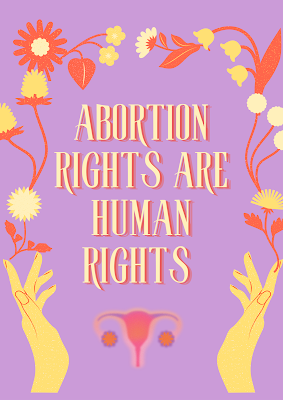
Poster 5's use of a strong purple background to represent justice, empowerment, and dignity is consistent with feminist campaigning ideas. Variations in access to abortion are graphically represented by a green-yellow-red gradient on the European map, which offers quick and obvious visual indicators of progressive and restrictive areas. With a text hierarchy that highlights important areas with bullet points and places the call-to-action message in bold, the contemporary sans-serif typeface guarantees clearness and approachability. In order to soften the harsh truths being conveyed, the layout balances a contrasting text box on the right with a map on the left that displays geographical and statistical data. The text boxes are divided by rounded edges. While the map itself enhances the poster's context and makes the disparities in reproductive rights across Europe immediately understandable, a circular emblem with the tagline "Her Voice, Her Choice" underlines the brand identification and solidarity.
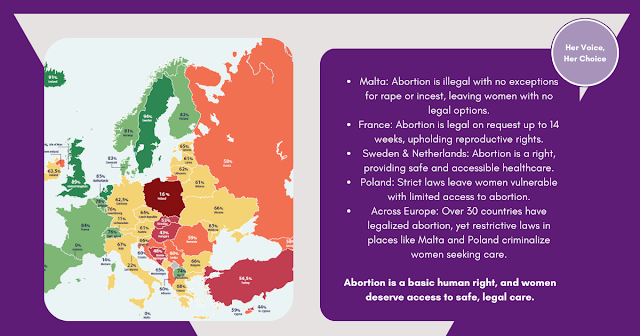
In order to make the message obvious and captivating, Poster 6 uses a striking colour scheme of purple, which represents women's rights and empowerment, green, which is a universal symbol of reproductive freedom, and pink to create contrast. With bolded text highlighting the urgency of addressing the mental health risks associated with unintended pregnancies, a contemporary sans-serif font offers accessibility and clarity. The layout incorporates circular elements to reflect inclusivity and unity, while diagonal cuts add a sense of movement and urgency, reinforcing the call for safe and legal abortion access. The illustration of a distressed woman powerfully highlights the mental health consequences of forced pregnancies, creating a visually impactful and compelling pro-choice message.
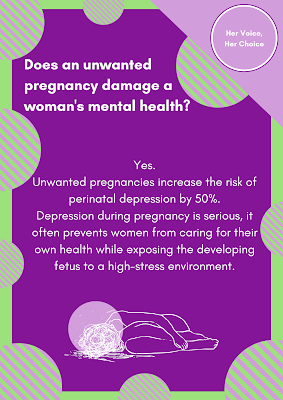
Poster 7's gentle pink and purple colour scheme evokes feelings of femininity, compassion, and serenity while supporting ideas of women's empowerment and body autonomy. The text and photographs are contrasted with a neutral beige background, which keeps the design simple and approachable. While the attribution text, in a more subdued typeface, adds context without taking away from the message, the main quote is typeset in a contemporary sans-serif font, guaranteeing clarity and simplicity. The circular "Her Voice, Her Choice" logo, which emphasises empowerment and unity, is paired with flowing, organic shapes, such pink and purple blobs, to represent inclusivity and tenderness. The black-and-white photograph by Simone Veil, which is positioned in the lower right corner, balances the dynamic, asymmetrical composition and adds historical relevance. The quote in the centre is the main attraction, and the white space makes the design feel clean and highlights the significance of the statement.
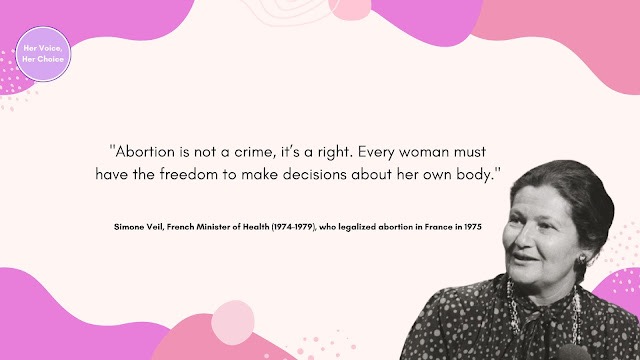
Section 3: Inspiration and Context
The Facebook group Voice for Choice – L-Għażla Tagħna, which is a coalition of civil society organisations (NGOs) in Malta that collaborate to promote reproductive justice and rights, served as my inspiration for this project. A pro-choice advocacy organisation called Voice for Choice is committed to advancing gender equality and giving women the freedom to make their own decisions regarding their bodies. Through educational articles, campaigns, and events that promote access to healthcare, abortion, and contraception, the organisation spreads awareness about reproductive freedom. In addition to data about abortion and women, its content frequently consists of personal narratives, legal changes, and educational materials. My design decisions were greatly influenced by the page's colour scheme, which includes green for growth, hope, and progress, purple for feminism, justice, and empowerment, and white for purity, peace, and equality. These hues are all in line with their goal of promoting social change and reproductive rights in Malta.
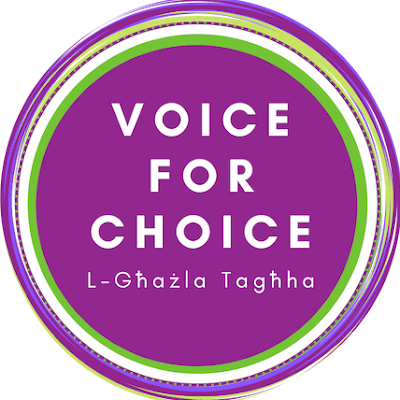
Section 4: Project Objectives and Target Audience
The primary reason I chose a pro-choice stance for my abortion project is to increase awareness of women's autonomy and abortion rights, especially in the European setting. Malta is unique in that it has one of the strictest abortion regulations in Europe, allowing the procedure only when the life of the pregnant woman is in danger. In stark contrast, abortion is available upon request in nations like Sweden and the Netherlands. There are significant differences between Malta and the rest of the continent, as over 95% other European countries permit abortion under more general circumstances, according to the Centre for Reproductive Rights (2023).
This project's target audience consists of a number of important groups. First, women will receive crucial information and help to defend their rights in restrictive nations, especially those with laws that restrict access to abortion. Second, there will be helpful content to support the work of pro-choice activists looking for tools and resources to increase their activity. The effort can convince policymakers, a crucial audience, to support the adoption of just and equitable abortion laws. The project's messaging will inspire empathy and compassion in the general public, particularly among those who are not aware of the obstacles related to access to abortion. Last but not least, a sizable audience consists of younger generations, especially socially concerned young people who use sites like Facebook.
Section 5: Medium and Design Choices
Since Facebook has a large audience and enables me to communicate with both people who are directly impacted by abortion restrictions and people who are not aware of the issue, I decided to utilise it as the platform for my project. The platform encourages conversation by establishing a forum for debates around abortion rights and eliminating the taboo around this contentious issue. It is an efficient instrument for disseminating messages and calls to action because of its narrative and visual elements, which include the sharing of written information and posters. Furthermore, Facebook's ease of use guarantees accessibility for users of all ages, particularly younger audiences who play a critical role in influencing social change.
.
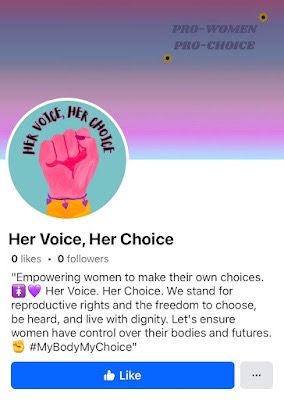
I chose a cover photo for my Facebook page's visual and narrative strategy that features brilliant yellow sunflowers to represent optimism, hope, and resiliency, and a gradient backdrop that changes from pink to blue, signifying inclusivity and serenity. While the sunflowers' haphazard arrangement provides visual intrigue and connotation of growth and life, the text's powerful serif font lends the message weight and formality.
The message is kept straightforward and unambiguous by the basic style. A bright pink fist, signifying empowerment, and a purple bracelet and yellow sleeve, signifying hope, vitality, and justice, are shown on the profile picture's serene teal background. The raised fist at the centre of the design symbolises resistance and togetherness, while the contemporary sans-serif type strengthens the impact and clarity of the slogan "Her Voice, Her Choice." The colour blocks guarantee reading in the tiny profile photo format, and the charm bracelet's little heart charms delicately and compassionately balance the force of the fist.
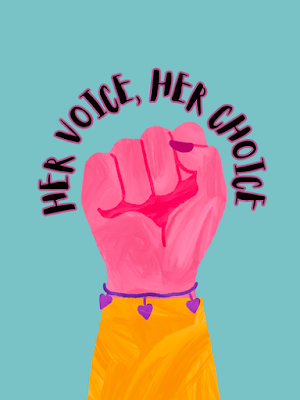
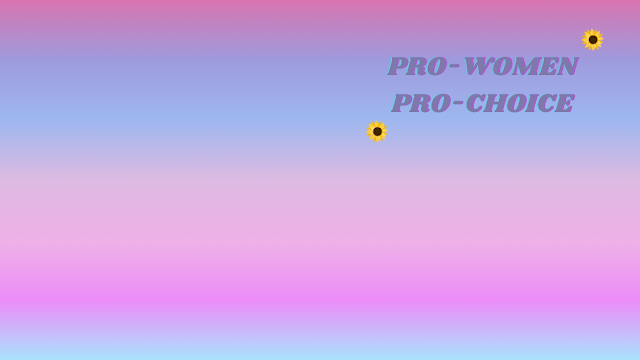
Facebook Posts:
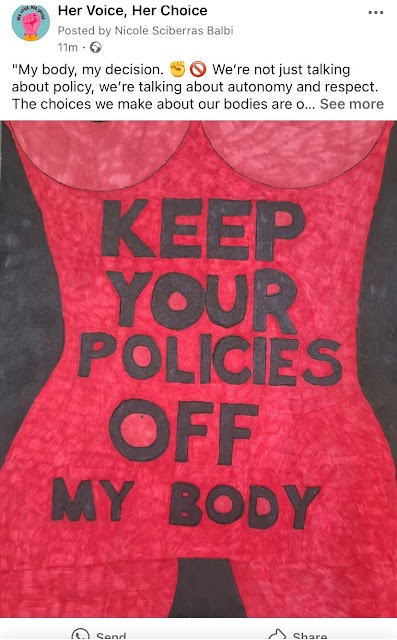
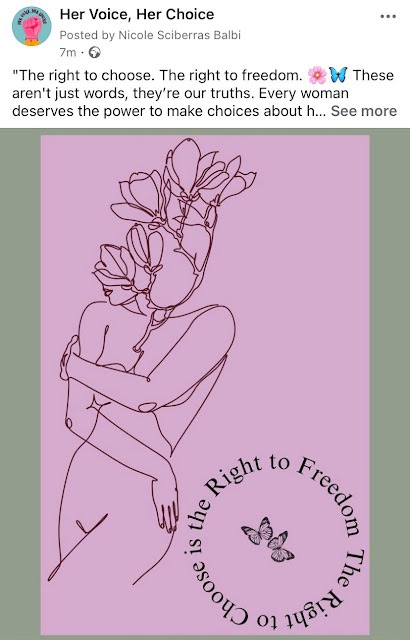
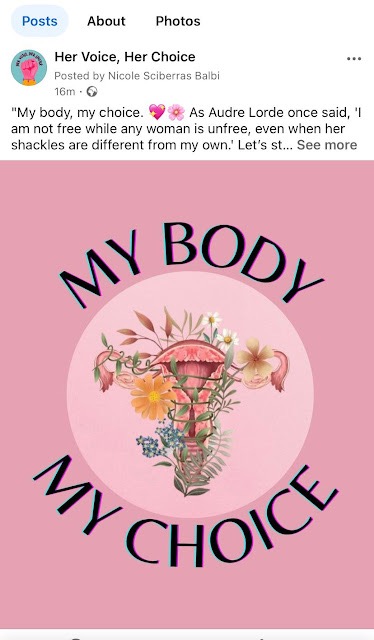
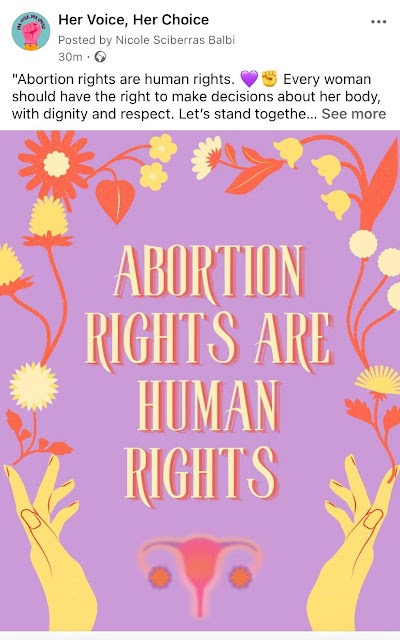
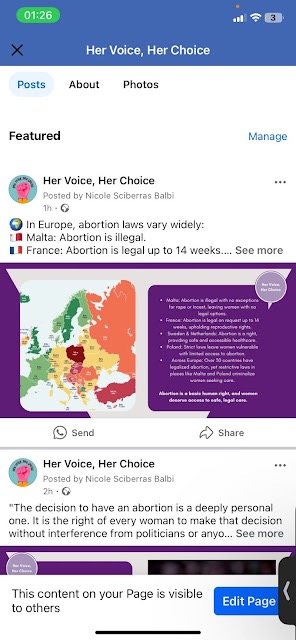
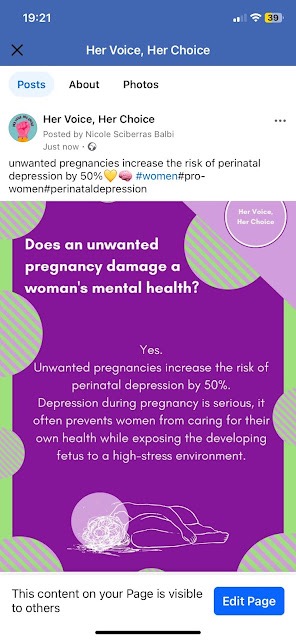
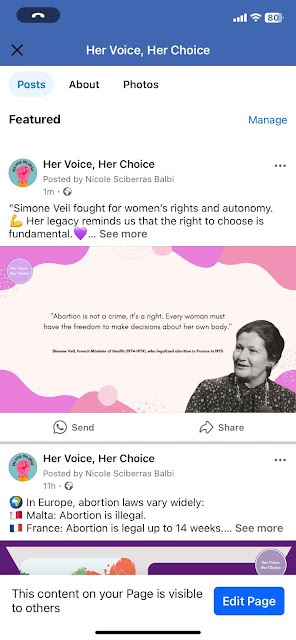
Section 6: Name, Impact, and Engagement Goals
The reason I chose the name "Her Voice for Choice" for my page is that it embodies the pro-choice movement's tenets of autonomy, empowerment, and reproductive rights. "Her Voice" underscores the significance of women's autonomy in making decisions regarding their bodies, while "Choice" represents the more comprehensive right to govern one's own destiny, encompassing choices regarding healthcare, birth control, and abortion. By offering a forum for individuals battling for women's equality and rights, the page seeks to increase awareness, support reproductive autonomy, and encourage legislative reform.
My research has had a major influence on increasing knowledge of reproductive rights and bodily autonomy, especially in Malta where abortion regulations are quite restricted. Through the use of hashtags like #MyBodyMyChoice and #ReproductiveRights, the Facebook page generated discussions and interaction on this contentious topic. It questioned social conventions by getting viewers to think about other viewpoints and oppose Malta's restrictive legislation. The inspirational sayings, eye-catching imagery, and simple language encouraged women to fight for their rights.
The project informed the public on the advantages of easily available abortion services and brought attention to the differences in reproductive rights by presenting the disparate abortion laws across Europe. In my pro-choice Facebook campaign, I used emojis and hashtags to boost visibility, interaction, and clarity. While emojis like hearts ❤️ and flowers 🌸 express empowerment, love, and growth, hashtags like #MyBodyMyChoice aid in reaching a wider audience and emotionally connect with the subject of reproductive rights. My choice of colors—purple, pink, and pastels—aligns with the movement's ideals and fosters a friendly and encouraging environment for proponents of choice.
Strengths and weaknesses
The project's strong narrative and visual impact, topical framing, and timely, pertinent subject matter are among my project's strong points and drawbacks. During the process, I developed empathy and inclusivity while critically interacting with political communication and growing myself. I did, however, have difficulties balancing emotional sensitivity, engaging opposing audiences, addressing the potential of bias, and being impartial. The breadth of the research and time constraints made it difficult to properly explore the problem.
Inspiration:
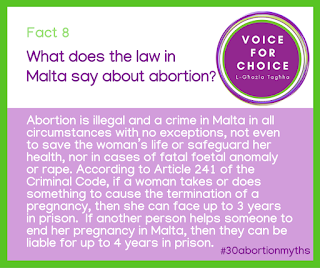
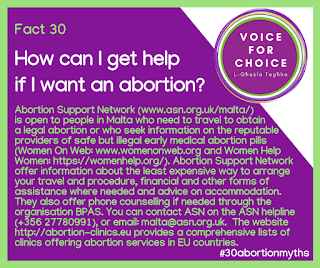
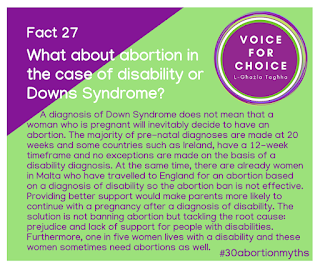
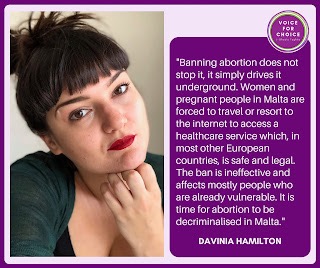
References:
- JEANTET, D., 2024b. Hundreds rally in the streets of Paris to support world abortion rights. [online] AP News. Available at: <https://apnews.com/article/abortion-rights-france-paris-protest-women-553a060cb9e157b4d15dc830f81607b7>.
- Diamondstein, M., 2022b. European Abortion Laws: A Comparative Overview. [online] Center for Reproductive Rights. Available at: <https://reproductiverights.org/european-abortion-laws-comparative-overview/>.
- Anon. n.d. PACE website. [online] assembly.coe.int. Available at: <https://assembly.coe.int/nw/xml/XRef/Xref-XML2HTML-en.asp?fileid=17638>.
- Anon. 2022a. Unintended Pregnancy and Abortion in Europe. [online] Guttmacher Institute. Available at: <https://www.guttmacher.org/fact-sheet/unintended-pregnancy-and-abortion-europe>
- Anon. 2025. Nationalist Party, Repubblika target PBS for stifling journalism following TV presenter’s resignation. [online] MaltaToday.com.mt. Available at: <https://www.maltatoday.com.mt/news/national/111234/marlene_farrugia_abortion_bill> [Accessed 28 January 2025].
- Fetterolf, J. and Clancy, L., 2024. Support for legal abortion is widespread in many countries, especially in Europe. [online] Pew Research Center. Available at: <https://www.pewresearch.org/sh... Staff, 2024. Abortion laws in Europe. Reuters. [online] 15 Apr. Available at: <https://www.reuters.com/world/europe/abortion-laws-europe-2024-04-15/>.
- Anon. 2020. Legal time frames for abortion in European countries 2020 | Statista. [online] Statista. Available at: <https://www.statista.com/statistics/1268439/legal-abortion-time-frames-in-europe/>.
- Anon. 2020b. Poland abortion ruling: Protests spread across the country. BBC News. [online] 23 Oct. Available at: <https://www.bbc.com/news/world... Staff, 2024b.
- France’s Macron wants to make abortion a right at EU level. Reuters. [online] 8 Mar. Available at: <https://www.reuters.com/world/europe/frances-macron-wants-make-abortion-right-eu-level-2024-03-08/>.
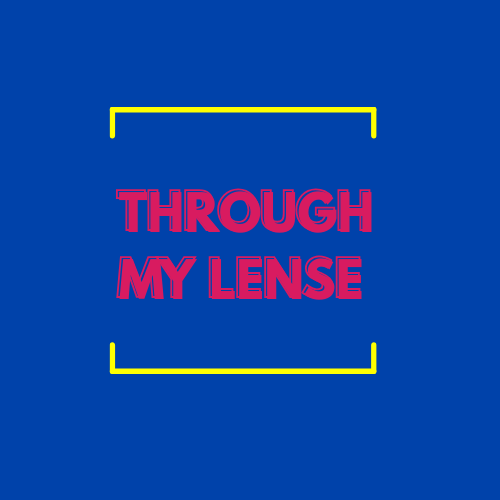
Post a comment